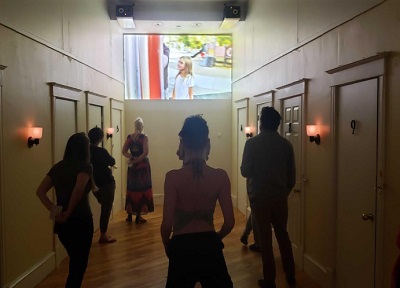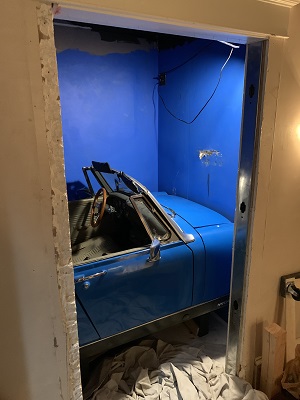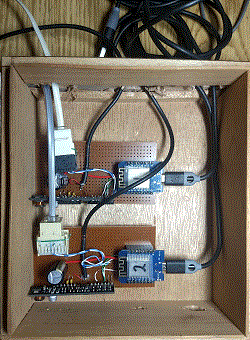A Brief Waltz in a Little Room
Umbrella Theater co-produced Sackerson's "A Brief Waltz in a Little Room, 23 Short Plays About Walter Eyer" which opened on August 21, 2019, at the Urban Art Gallery in the Gateway.

The genesis of the production was ten fitting rooms at the back of the gallery, a remnant from when it was a clothing store in the Gateway shopping center. Sackerson has previously done immersive theater in spaces ranging from a box to walking around downtown Salt Lake City. The concept here was to have the audience convene together for an opening video. Then ten different segments would be performed with each audience member going through the ten rooms in a sequence determined by a card they were handed. That was followed by everybody getting together again and then ten more segments in the rooms, followed by the conclusion in the common space.
Our artistic director, Jamie Rocha Allan, directed some of the segments and assisted the directors of the others.
Umbrella was responsible for the technical aspects of the show, with our technical director, Cara Pomeroy, supervising the designers for each of the rooms and providing the materials that they needed. The designers, and the rooms that they designed were:
- Maddy Ashton: Mirror Room
- Adam Day: Car room
- Dan Evans: Phone room & Conversion therapy office
- Sophia Luker: Bed room
- Brooke Morgan: Outdoor space
- Cara Pomeroy: Living room
- Spencer Potter: Church
- Heather Poulsen: Bathroom
- Iris Salazar: Closet
Many of these designers were supported under Umbrella's mentorship program, which gives aspiring designers (and in other instances, directors) a chance to have primary responsibility for a production while able to call on an experienced mentor when desired. This production was especially suited for the program, because the rooms could be treated as separate productions.

Each room presented its own challenges, including fitting an actual car (or at least most of one) through the doorway of one of the rooms!
The final member of Umbrella's team, our managing director Lee Hollaar, was able to use his background in electrical engineering and computer science to help this production. At the start, he was invaluable in safely adapting the electrical system of the old fitting rooms, including adding the lighting dimmers from Umbrella to control fixtures in the rooms and central area. Umbrella also supplied fixtures such as the ETC Source Four Mini LED that was used to illuminate a picture in the Church room, using its shutters to match the angled picture frame and keeping down the heat in the room. (It and other lighting and sound equipment is available for loan to other small theater companies. See Umbrella's equipment web page for more information.)
Umbrella also provided a television camera and set up the wiring so that activity in one of the rooms could be projected on the ceiling of another one.

An iteresting challenge was the Telephone room. In the first act, it would provide nine phones on the wall that would play a message as each was lifted, while in the second act there would be a phone in the center of the room that would ring and play another message when answered.
The control for those phones was provided by two boards that were based on a stage phone ringer previously designed by Hollaar. It consisted of an inexpensive subscriber-line interface card (SLIC) and the microprocessor he had previously used at Pioneer Theatre to control LED strips and strings used in their sets and props such as candelabra. Two variants of the board were programmed, one for each act.
For the first act, whenever a phone was picked up a command was sent to a computer running QLab to play a particular sound cue, which was then sent to the phones. (All phones were connected together, so the cue could be heard on any phone, but because the audience member was listening only through a single phone at a time that was not noticeable.) The cue was stopped when it was completed or when the phone was hung up. An Art-Net lighting cue was used to indicate that we were in Act 1 and this function should be enabled.
Another lighting cue was used to ring the phone placed in the center of the room for Act 2. When it was answered, QLab was signaled to place a sound cue. WiFi was used to send Art-Net messages from QLab to the microprocessor on the board (an ESP8266, which contains a WiFi interface), and OSC (Open Sound Control) messages from the microprocessor to QLab to start and stop sound cues.
The QLab program was also used to control five channels of DMX dimming for the sconces in the common area and lighting fixtures in the rooms, as well as other sound and video cues for the production. This provided a unified show control console, that could be operated by a single person.
Dave Mortensen, Sackerson's director of this production says "Umbrella Theater Company was integral to the success of this production. Converting a non-traditional space into a theatre venue is always a challenge, but this show had its own unique hurdles. Their expertise in construction, electrical engineering, design, and storytelling were a tremendous help to strengthen Sackerson's team and vision for the production. Additionally, their stock of equipment and the artist mentorship program helped to produce a show for under $10k that would have normally cost three times that. Umbrella is an innovative resource to the Utah community. Our show would not have been the great success it was if not for their partnership."